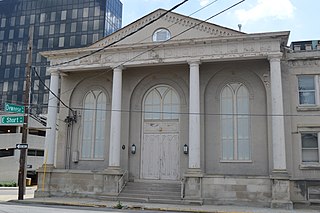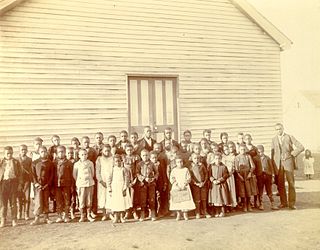
Lexington is a city in Kentucky, United States, and the county seat of Fayette County. By population, it is the 2nd most populous city in Kentucky after Louisville and 60th-most populous city in the United States. By land area, it is the country's 28th-largest city. The city is also known as "Horse Capital of the World". It is within the state's Bluegrass region. Notable locations within the city include the Kentucky Horse Park, The Red Mile and Keeneland race courses, Rupp Arena, Central Bank Center, Transylvania University, the University of Kentucky, Bluegrass Community and Technical College, and the National Thoroughbred Racing Association (NTRA) Headquarters.

Frankfort is the capital city of the U.S. state of Kentucky and the seat of Franklin County. It is a home rule-class city. The population was 28,602 at the 2020 United States census. Located along the Kentucky River, Frankfort is the principal city of the Frankfort, Kentucky Micropolitan Statistical Area, which includes all of Franklin and Anderson counties. It is the fourth smallest state capital city in the United States by population.

Newport is a home rule-class city at the confluence of the Ohio and Licking rivers in Campbell County, Kentucky, United States. The population was 14,150 at the 2020 census. Historically, it was one of four county seats of Campbell County. Newport is a major urban center of Northern Kentucky and is part of the Cincinnati metropolitan area.

Winchester is a home rule-class city in and the county seat of Clark County, Kentucky, United States. The population was 18,368 at the 2010 census. It is part of the Lexington-Fayette, KY Metropolitan Statistical Area. Winchester is located roughly halfway between Lexington and Mt. Sterling.

Laura Clay, co-founder and first president of the Kentucky Equal Rights Association, was a leader of the American women's suffrage movement. She was one of the most important suffragists in the South, favoring the states' rights approach to suffrage. A powerful orator, she was active in the Democratic Party and had important leadership roles in local, state and national politics. In 1920 at the Democratic National Convention, she was one of two women, alongside Cora Wilson Stewart, to be the first women to have their names placed into nomination for the presidency at the convention of a major political party.

The following outline is provided as an overview of and topical guide to the United States Commonwealth of Kentucky:

First African Baptist Church is a Baptist church at 264-272 E. Short Street in Lexington, Kentucky. The congregation was founded c. 1790 by Peter Durrett and his wife, slaves who came to Kentucky with their master, Rev. Joseph Craig, in 1781 with "The Travelling Church" of Baptists from Spotsylvania, Virginia.

Kentucky Equal Rights Association (KERA) was the first permanent statewide women's rights organization in Kentucky. Founded in November 1888, the KERA voted in 1920 to transmute itself into the Kentucky League of Women Voters to continue its many and diverse progressive efforts on behalf of women's rights.
The following is a timeline of the history of Somerville, Massachusetts, US.
The following is a timeline of the history of the city of Cincinnati, Ohio, USA.
The following is a timeline of the history of the city of Louisville, Kentucky, USA.
The following is a timeline of the history of the city of Baltimore, Maryland, USA.

Douglass School in Lexington, Kentucky, US, was both a primary and secondary Fayette County Public Schools from 1929 to 1971. Douglass School operated solely for African American students. The building that once housed Douglass School, located at 465 Price Road, was listed on the National Register of Historic Places in Fayette County in 1998.
The following is a timeline of the history of the city of Jacksonville, Florida, USA.

Cadentown School in Lexington, Kentucky was a primary public school for black children in the segregated Fayette County Public Schools from about 1879 to 1922. The building that originally housed Cadentown School, located at 705 Caden Lane, is no longer extant. However, the Rosenwald Fund School is listed on the National Register of Historic Places in Fayette County.
The following is a timeline of the history of the city of Memphis, Tennessee, US.
The following is a timeline of the history of the city of Chattanooga, Tennessee, United States.

The Travelling Church was a large group of pioneering settlers in the late 1700s that emigrated from Spotsylvania County, Virginia, to the Kentucky District of Virginia. It was the largest group that migrated to the area in a single movement. The group was led by the Reverend Lewis Craig, one of three pastor sons of Toliver Craig Sr., and its core was his Baptist congregation. The group of about 600 people arrived at Gilbert's Creek, Kentucky, in December 1781. Other preachers in the Travelling Church were Lewis Craig's younger brother Rev. Joseph Craig and his beloved slave Peter Durrett, who later became a pioneering black minister in Lexington, Kentucky. Lewis Craig's other brother who was a minister, Rev. Elijah Craig, did not come with the rest of the Church, as he remained for a while in Virginia to help James Madison establish constitutional religious liberty assurances before joining the group later. The group's pioneering members were to found many churches, settlements, and other institutions that continue to this day.

Elise Clay Bennett Smith, President of the Kentucky Equal Rights Association from 1915–1916, also served as an Executive Committee member for the National American Woman Suffrage Association. Her last name changed several times as she married three men in succession: from her birth surname of Bennett she became Smith, then Jefferson, and finally Gagliardini.

Christine Bradley South was president of the Kentucky Equal Rights Association for three years (1916-1919). She was a Vice-President of KERA when her cousin, Governor Edwin P. Morrow, signed into law Kentucky's ratification of the Nineteenth Amendment on January 6, 1920. She served as a delegate from Kentucky to the Republican National Convention in 1920, 1928 and 1932; and in 1937 she served on the Republican National Committee.

















